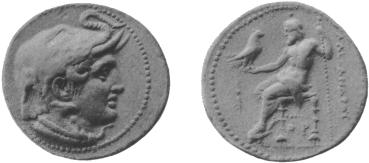
FIG. 373.



Naucratis. The style is that of the fourth century B.C. The two or three extant specimens have all been found on the site of the famous Greek emporium.
| Female head r., wreathed; beneath, ΝΑΥ. [N. C., 1886, Pl. I. 9; 1902, Pl. XVII. 10.] | Beardless head r., wreathed; short,
flying hair; beneath, ΑΛΕ. Æ .6
|
[R. S. Poole, Brit. Mus. Cat., The Ptolemies, 1883; J. N. Svoronos, Τα Νομισματα του Κπατους των Πτολεμαιων, vols. i-iii, 1904, and vol. iv (with German translation of vol. i), 1908; K. Regling, Z. f. N., xxv, pp. 344-99.]
The long series of the coins of the Ptolemies is generally admitted to be the most difficult to classify in the whole range of Greek numis- matics. In spite of the enormous number of issues, the types present comparatively little variety. The inscriptions are mostly conventional and, although dates are frequent, the era of reckoning is not always certain. Again, while some mint-marks—notably those of Phoenician, Palestinian, and Cyprian cities—are easily recognized, there are many coins that bear either no mint-mark at all or one of doubtful significance. Finally, our information as to finds is anything but adequate. This last circumstance is much to be regretted. A knowledge of the manner in which the coins are normally associated in hoards, and of the localities whence particular varieties come, would be of immense service in dealing with the problem of arrangement. As yet a final solution is hardly within sight. The late Dr. R. S. Poole laid the foundations of a scientific study of the subject, and his classification was for many years universally accepted as trustworthy. The publication of the mass of material brought together by Dr. J. N. Svoronos has shown that not a few of Poole’s conclusions are untenable. Whether the alternative attributions proposed by Svoronos are in all cases sound, is a question regarding which there is room for considerable difference of opinion; cf. Regling’s exhaustive criticism in Z. f. N., xxv. [1] But in any event his book marks a most substantial advance, and it will necessarily form the groundwork of the brief outline which is all that can be given within the limits of this manual.
We have seen that the oldest Egyptian coins were Attic staters and tetradrachms having the name and types of Alexander. Modifications were soon introduced, but the weight at first remained unaltered. Presently, however, after a period of transition, during which Rhodian tetradrachms and smaller AR make a fitful appearance, the Attic standard was definitely superseded by the Phoenician. The change took place shortly after B.C. 305. Probably it was not unconnected with the difficulty that must have been experienced in combining the Attic with the native Egyptian system, and particularly in adjusting the relations between coins of gold and silver on the one hand and coins of copper on the other. The papyri furnish striking testimony to the exceptional position occupied by the last-named metal in Egypt. Down to the end of the third century B.C. accounts are always stated on the basis of a silver standard, the values being expressed in drachmae, obols, and chalkoi. From the reign of Ptolemy Epiphanes onwards the standard of reckoning is a copper one, the unit of value being the δραχμη χαλκου, which exchanged with the δραχμη αργυριου at rates varying from 350:1 to 500:1. Thus much is clear. But behind lie questions at once intricate and obscure, for which see the luminous discussion by Grenfell and his colleagues in Tebtunis Papyri, i, pp. 580-603, where it is shown
1 Svoronos has reprinted this extremely useful article in Νομ. Πτολ., iv, pp. 455 ff.
The ordinary method of dating is by regnal years. From circ. B.C. 200 onwards the numeral is regularly preceded by the symbol L, which is also of common occurrence in Ptolemaic papyri. This was formerly supposed to be an Egyptian sign, perhaps of demotic origin, but it may be no more than a fragmentary survival of the initial Ε of ΕΤΟVΣ (J. H. S., 1902, pp. 149 ff). Apart from regnal years, Poole noted on one group of coins a series of dates running beyond 100, and therefore obviously calculated on a different principle (B. M. C., pp. lxxiv ff. and 101 ff.). Svoronos has made out a good case for believing that Poole’s ‘uncertain era’ was reckoned from B.C. 311, when the death of Alexander IV relieved Ptolemy from even nominal dependence on a suzerain (Rev. Belge, 1901, pp. 413 ff.). His arguments for such an ‘era of Soter’, though in themselves not quite conclusive, receive strong support from the circumstance that the dating of a Tyrian inscription had already suggested a similar inference to Strack (Dyn. der Ptol., pp. 149 ff.). Less convincing is his assumption of another era com- mencing with the death or, rather, the deification of Arsinoë II in B.C. 270 (Νομ. Πτολ., i, pp. ρμη-ρξβ, and iv, pp. 83-95). The grounds of conjecture here are more slender, and the resulting arrangement of coins has yet to be confirmed by other evidence. Still, the hypothesis is ingenious. It accounts for some curious coincidences. And it has therefore established a claim to at least provisional acceptance. The same may perhaps be said of his theory of χρυσα δεκαετηριδων, according to which certain AV pieces of a medallic character were issued in various reigns in commemoration of the tenth anniversary of the royal marriage. They are chiefly octadrachms, and may be thus described; obv. Head of queen, with Κ [= 10] behind; rev. ΑΡΣΙΝΟΗΣ ΦΙΛΑΔΕΛΦΟΥ, Double cornucopiae. Many of the Ptolemaic coins bear magistrates’ monograms or initials. Surmises as to the actual names which these represent should be received with great caution.
Ptolemy I (Soter), B.C. 323-285, ruled Egypt until B.C. 311 as the satrap Of Philip Aridaeus and of Alexander IV; thereafter, inde-
1 It is also significant that a πενταδραχμον νομισμα was the coin employed to set in motion the automatic machines that supplied the devout with lustral water at the doors of certain temples in Alexandreia (Heron, Πνευματικα, i. 21).

Period I (B.C. 323-305). Ptolemy’s earliest money was struck in the names of his successive suzerains, the types being those of Alexander the Great. Before long, however,—perhaps on the death of Philip in B.C. 316—the familiar head of Herakles on the tetradrachms was replaced by a head of Alexander the Great in elephant-skin (Fig. 373). The normal weight is Attic, and the usual inscr. ΑΛΕΞΑΝΔΡΟΥ (Svor., Nos. 18-24). A set of rare anonymous pieces (Svor., Nos. 25 f.), with the same obv. but with rev. Prow (AV staters) or Eagle (AR ½ obols), may have been issued when Alexander IV died (B.C. 311). If so, anonymity did not suit the public taste, for ΑΛΕΞΑΝΔΡΟΥ reappears on a much larger group (Svor., Nos. 33-58) that must fall between B.C. 311 and 305. This contains AV with Alexandrine types (N. C., 1892, Pl. II. 9) and also Æ (B. M. C., Pl. I. 4, 7). Its chief feature, however, is AR distinguished by a novel rev. type and by the introduction of the Rhodian standard:—
| Head of Alexander the Great in ele- phant-skin. [B. M. C., Pl. I. 2.] | Archaistic figure of Athena Proma-
chos, hurling fulmen; in field, eagle.
AR Attic Tetradrs.
|
| Id. [B. M. C., Pl. I. 3.] | Id. AR Rhodian Drs. and ½ Drs.
|
The transition to the next period is marked by a tetradrachm of Rhodian weight with the types just described but with inscr. ΠΤΟΛΕΜΑΙΟΥ (N. C., 1900, Pl. I. 15). Another, still of Attic weight, reads ΠΤΟΛΕΜΑΙΟΥ ΑΛΕΞΑΝΔΡΕΙΟΝ [1] (Svor., No. 32). Presumably the whole of the foregoing were minted in Egypt. For AV issued in Cyprus by Ptolemy’s brother Menelaus and by his son-in-law Eunostus see supra, pp. 744 f. A series of Æ, probably Cyprian but slightly later (Svor., Nos. 74-82), has: obv. Head of Aphrodite; rev. ΠΤΟΛΕΜΑΙΟΥ, Eagle on fulmen (B. M. C., Pl. I. 9). In the Cyrenaïca, side by side with autonomous AR, for which see infra, there were struck AV staters and ½ staters (Svor., Nos. 59-64) with ΑΛΕΞΑΝΔΡΟΥ, ΠΤΟΛΕΜΑΙΩ (or ΠΤΟΛΕΜΑΙΟΥ) ΚΥΡΑΝΑΙΟΝ, &c. (N. C., 1894, Pl. VIII. 5), and also Æ with ΠΤΟΛΕΜΑΙΟΥ (Svor., Nos. 65-71).
1 That is, ‘coin of Alexander, struck by Ptolemy.’ Svoronos (i, p. νη, and iv, p. 11) renders ‘coin of Alexandreia, struck by Ptolemy’, citing as analogies ΝΙΚΟΚΛΕΟΥΣ ΠΑΦΙΟΝ and ΠΤΟΛΕΜΑΙΩ (or ΠΤΟΛΕΜΑΙΟΥ) ΚΥΡΑΝΑΙΟΝ. But, in the absence of any local coinage of Alexandreia, there is no warrant for departing from the ordinary meaning of Αλεξανδρειον (Pollux, Onom., ix. 84), particularly when it gives an excellent sense.
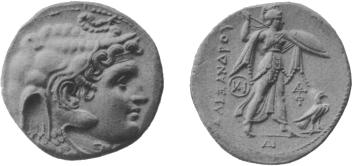
Period II (B.C. 305-285). The appearance of βασιλευς fixes the date of an important group (Svor., Nos. 101-80), the various members of which are proved by monograms, &c., to be intimately connected, differences of inscr. notwithstanding:—
| Head of Ptolemy I, diademed and wear- ing aegis. [B. M. C., Pl. II. 10 f.] | ΠΤΟΛΕΜΑΙΟΥ Alexander, as son of
ΒΑΣΙΛΕΩΣ Ammon, in quadriga
of elephants. AV 110 grs. Phoen. Stater.
|
| Head of Alexander the Great in ele- phant-skin (Fig. 374). | ΑΛΕΞΑΝΔΡΟΥ Archaistic figure of
Athena Promachos, hurling fulmen;
in field, eagle on fulmen.
AR Rhodian Tetradr.
|
| Head of Alexander the Great, horned; hair long. [B. M. C., Pl. II. 1.] | ΠΤΟΛΕΜΑΙΟΥ (sometimes withΒΑΣΙ-
ΛΕΩΣ) Eagle on fulmen. Æ .85-.7
|
The use of the Phoenician standard for the AV should be noted. The weight of the AR tetradrachms possibly indicates that they were intended for foreign commerce. The majority, however, were certainly minted in Egypt itself; some of them have on the obv. a microscopic Δ, probably an engraver’s signature, and this recurs frequently on the larger denominations of what must be regarded as the true regal coinage of Ptolemy I, struck in Egypt for Egyptian needs (Svor., Nos. 181-303). The standard of the latter is Phoenician for AV and AR alike, and the types in these metals are those generally adhered to afterwards down to the Roman occupation:—
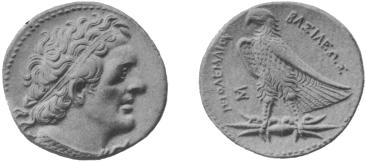
| Head of Ptolemy I, diademed and wear- ing aegis (Fig. 375). | ΒΑΣΙΛΕΩΣ ΠΤΟΛΕΜΑΙΟΥ Eagle on
fulmen; in field, monogram.
AR Phoen. Tetradr.
|
The AV comprised pentadrachms and triobols, the eagle’s wings on the latter being open (B. M. C., Pl. III. 5), while the AR included not only tetradrachms, but also octadrachms (Z. f. N., xxi. Pl. VI. 8). The
Ptolemy II (Philadelphus), B.C. 285-246, is said by Appian (Praef. x) to have been και πορισαι δεινοτατος βασιλεων και δαπανησαι λαμπροτατος και κατασκευοσαι μεγαλουργοτατος, a description aptly illustrated by the profusion and almost barbaric magnificence of his coinage. He became king two years before his father’s death, Soter having voluntarily abdicated in order to ensure that he should be succeeded by the son of his choice rather than by the impetuous Keraunos. At first the types remained unaltered (Svor., Nos. 338-87). Indeed, it is doubtful whether the pieces struck by father and son respectively can now be distinguished (Z. f. N., xxv, p. 353), although Svoronos assigns all the AV triobols and AR octadrachms to Soter, while crediting Philadelphus with the introduction of the AR drachm (Rev. Eagle with open wings) and also with certain innovations in the Æ, notably the adoption of the head of Arsinoë II as an obv. type (B. M. C., Pl. XIII. 10). [1] He believes that this coinage lasted till B.C. 271, the only other contemporary issue being a set of AR tetradrachms (Svor., Nos. 388-407) with the usual types but with inscr. ΠΤΟΛΕΜΑΙΟΥ ΣΩΤΗΡΟΣ (B. M. C., Pl. X. 3 f., and XIV. 8).
The deification of Arsinoë II, on her death in B.C. 270, was a master- stroke of financial policy (Strack, Rhein. Mus., 1900, pp. 164 ff.). Involving as it did the diversion into the royal treasury of a rich stream of temple dues, it seems to have led to a complete reorganization of the coinage (Svor., Nos. 408-519):—
| Head of Arsinoë II, veiled and wearing stephane. [B. M. C., Pl. VIII. 4.] | ΑΡΣΙΝΟΗΣ ΦΙΛΑΔΕΛΦΟΥ Double
cornucopiae, filleted. AV Octadrachm.
|
| Id. [Ward Coll., Pl. XXII. 888.] | Id. AR Decadrachm.
|
| Id. [B. M. C., Pl. VIII. 3.] | ΑΡΣΙΝΟΗΣ ΦΙΛΑΔΕΛΦΟΥ Eagle on
fulmen. AR Tetradrachm.
|
| Head of Ptolemy I, diademed and wear- ing aegis. [B. M. C., Pl. X. 5.] | ΠΤΟΛΕΜΑΙΟΥ ΣΩΤΗΡΟΣ Id.
AR Tetradrachm.
|
The weight is Phoenician. On nearly all there appears behind the head a numeral letter or letters, interpreted by Svoronos as dates reckoned from the ‘Era of Arsinoë’ (see supra, p. 847). Corresponding letters occur on the rev. of eight denominations of associated Æ, some of which are of exceptional size and weight: obv. Head of Ammon, or of Alexander; rev. ΒΑΣΙΛΕΩΣ ΠΤΟΛΕΜΑΙΟΥ Eagle, or Two eagles, on fulmen (B. M. C., Pl. V. 7-9, VI. 4, X. 2, 6 f.). A few AV octa- drachms with types and inscr. as above, but with no numeral letter, bear mint-marks of Cyprian cities (Svor., Nos. 520-3). Other series (Svor., Nos. 524-602), some of which may be Cyprian,
1 It is in this period that we first find the central hole which is so characteristic a feature of Ptolemaic Æ coins.
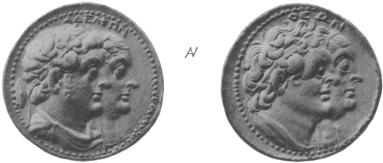
| ΑΔΕΛΦΩΝ Heads of Ptolemy II and Arsinoë II, jugate; behind, shield blazoned with fulmen (Fig. 376.) | ΘΕΩΝ Heads of Ptolemy I and Bere-
nice I, jugate. AV Octadrachm.
|
The inscr. refers to the cult of Soter and his consort as θεοι αδελφοι. There are similar pieces of later style (cf. B. M. C., Pl. VII), which must have been struck by subsequent kings. Besides AV octadrachms, the series contained AV tetradrachms (B. M. C., Pl. VII. 1 and 3), didrachms, and drachms, as well as AR didrachms and ½ drachms—all very much alike, except that the ½ dr. had no inscr. (Hunter Cat., iii, Pl. LXXXI. 17). The AR tetradrachms, which are very rare, were of the ΠΤΟΛΕΜΑΙΟΥ ΣΩΤΗΡΟΣ class, while the types of the Æ were ordinary (B. M. C., Pl. IV. 4, 6). Sporadic letters are taken by Svoronos to be dates of the ‘Arsinoë era’, and the whole of the ΘΕΩΝ ΑΔΕΛΦΩΝ coins are believed by him to have been minted in the Cyrenaïca (Νομ. Πτολ., i, p. ση, and iv, p. 133). This is quite doubtful. On the other hand, a group of Æ (Svor., Nos. 854-74) with rev. ΒΑΣΙΛΕΩΣ ΠΤΟΛΕΜΑΙΟΥ Head of Libya (B. M. C., Pl. VI. 9 f.) was certainly struck there, either before or after B.C. 283-271, during which years the province was in revolt under Magas.
A long series (Svor., Nos. 626-838), many of them bearing regnal dates which must be those of Philadelphus, display the mint-marks of Tyre, Sidon, Ptolemaïs, Joppa, and Gaza. They are chiefly AR tetra- drachms of conventional types, reading ΒΑΣΙΛΕΩΣ ΠΤΟΛΕΜΑΙΟΥ or (later) ΠΤΟΛΕΜΑΙΟΥ ΣΩΤΗΡΟΣ (B. M. C., Pl. V. 1-6). But there are also AV pentadrachms (B. M. C., Pl. II. 2, III. 2) and, towards the end of the reign, very rare ‘Arsinoë’ octadrachms, as well as Æ. If Svoronos's view regarding Poole’s ‘uncertain era’ be correct (see supra, p. 847), then the AR ‘Soter’ tetradrachms dated 42-50 (Svor., Nos. 848-52) must have been struck B.C. 269-261. Their style (B. M. C., Pl. XXV. 1 f.) suggests
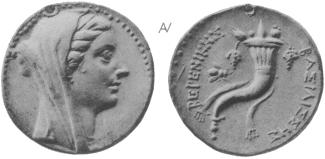
Ptolemy III (Euergetes), B.C. 246-221, brought the Cyrenaïca once again into close union with Egypt through his accession. According to Svoronos (Nos. 937-61), he continued the dated ‘Arsinoë’ series inaugu- rated by his father, limiting it, however, to AR decadrachms, which were issued annually till the close of his reign (B. M. C., Pl. VIII. 5). Possibly, too, he was responsible for some of the AV octadrachms of the ΘΕΩΝ ΑΔΕΛΦΩΝ class (Svor., No. 934). A quarrel with Seleucus II led him to invade the latter’s Eastern dominions in person, leaving Berenice to govern Egypt and control the operations of the fleet. It may be to his prolonged absence that we owe a notable set of coins (Svor., Nos. 962-82, 986-94), which are doubtless the Βερενικεια νομισματα of Pollux (Onom., ix. 84). The weight is Attic, [1] perhaps an indication that they were called for by the exigencies of the war in Asia Minor, and the types are: obv. Head of Berenice II; rev. ΒΑΣΙΛΙΣΣΗΣ ΒΕΡΕΝΙΚΗΣ Cornucopiae, with two stars on AV and two pilei on AR (B. M. C., Pl. XIII. 4-6). The following denominations are known—AV decadrachms, pentadrs., 2½ drs., drs., ½ drs., and ¼ drs.; AR dodecadrs. (?), pentadrs., 2½ drs. Along with these go eight denominations of Æ of the usual Ptolemaic types and with inscr. ΒΑΣΙΛΕΩΣ ΠΤΟΛΕΜΑΙΟΥ, but having generally a cornucopiae on the rev., either in front of the eagle or over its wing.
1 It has been generally supposed to be Phoenician. The larger denominations might be so explained, but not the drs. and ½ drs. It should be observed that this departure from the normal standard was only temporary. All the other coins of Euergetes are of Phoenician weight.
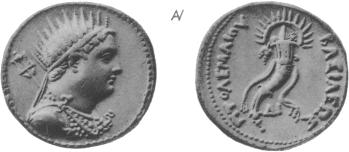
| Bust of Ptolemy III, radiate, wearing aegis, and carrying trident combined with sceptre (Fig. 378). | ΒΑΣΙΛΕΩΣ ΠΤΟΛΕΜΑΙΟΥ Cornu-
copiae, filleted and radiate.
AV Octadrs., Tetradrs., and Drs.
|
Five denominations of Æ (Svor., Nos. 1005-9) with rev. Cultus- statue of Aphrodite (B. M. C., Pl. XI. 1 f.) may have been struck in Cyprus or in Rhodes (Νομ. Πτολ., i, pp. σοδ ff., and iv, pp. 199 f.; Z. f. N., xxv, p. 366). In Phoenicia and Palestine Euergetes continued, for the first six years of his reign, the issue of dated AV ‘Arsinoë’ octadrachms and AR ‘Soter’ tetradrachms (B. M. C., Pl. VIII. 2, X. 1) which Phila- delphus had begun; see Svor., Nos. 1011-45. Svoronos (Nos. 1047-57) attributes to the same district Æ with obv. ΒΑΣΙΛΙΣΣΗΣ ΒΕΡΕΝΙΚΗΣ, Bust of Berenice, and rev. ΒΑΣΙΛΕΩΣ ΠΤΟΛΕΜΑΙΟΥ, Eagle or Cornu- copiae. There are other ‘Soter’ tetradrachms (Svor., Nos. 1001 and 1089-1112) which probably belong to this king, particularly those dated from the ‘Era of Soter’ (B. M. C., Pl. XXV. 3-7).
Ptolemy IV (Philopator), B.C. 221-204, a weak and dissolute ruler, was largely in the hands of favourites. Extant inscriptions (Strack, Dyn. der Ptol., pp. 237 ff., Nos. 55-8, 66) point to his having been closely associated with the worship of Sarapis and Isis. Svoronos may therefore well be right (Nos. 1123 f. and 1136) in ascribing to him the following:—
| Heads of Sarapis and Isis, jugate. [B. M. C., Pl. XVIII. 8.] | ΒΑΣΙΛΕΩΣ ΠΤΟΛΕΜΑΙΟΥ Eagle
on fulmen; cornucopiae on wing.
AR Tetradr.
|
Some of these tetradrachms have ΔΙ on the rev. The AV ‘Arsinoë’ octadrachm (Hunter Cat., iii, Pl. LXXXII. 14) and AR and Æ of ordinary types, also with ΔΙ, may possibly be contemporary (Svor., Nos. 1120-2, 1125-30). Svor., No. 1139, has the king’s own portrait:—
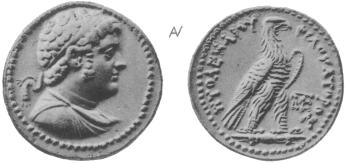
| Bust of Ptolemy IV, diademed, wearing chlamys (Fig. 379). | ΠΤΟΛΕΜΑΙΟΥ ΦΙΛΟΠΑΤΟΡΟΣ
Eagle on fulmen. AV Octadrachm.
|
Attached to the preceding is a group of Æ (Svor., Nos. 1140-52) with various types (Hunter Cat., iii, Pl. LXXXII. 18 f.; B. M. C., Pl. XVIII. 5). Another interesting class, which may be Cyprian (Svor., Nos. 1159-62), presents a portrait of the queen:—
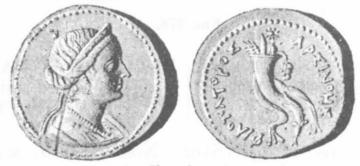
| Bust of Arsinoë III, wearing stephane; sceptre over shoulder (Fig. 380). | ΑΡΣΙΝΟΗΣ ΦΙΛΟΠΑΤΟΡΟΣ Cornu-
copiae filleted; above, star.
AV Octadrachm.
|
The Æ with like types read ΒΑΣΙΛΕΩΣ ΠΤΟΛΕΜΑΙΟΥ. Rare AV ‘Arsinoë’ octadrachms which Svoronos places here (Nos. 1163-5), believing them to have been struck on the occasion of Philopator's marriage, show stylistic divergences which render his hypothesis difficult to accept (Hunter Cat., iii, Pl. LXXXIII. 2 f.). A remarkable class, some of which bear mint-marks (Tyre, Sidon, Ascalon, and Ptolemaïs), others regnal dates (= B.C. 219 and 218), is characterized by the presence of ΣΩ, probably indicating Sosibius, Philopator’s chief minister (Svor., Nos. 1177-95). Besides AV octadrachms similar to Fig. 379 (Hunter Cat., iii, Pl. LXXXIII. 5 f.) and Æ of ordinary types, it contains several varieties of AR tetradrachms—(α) Obv. Bust of Ptolemy IV, Rev. ΒΑ- ΣΙΛΕΩΣ ΠΤΟΛΕΜΑΙΟΥ or ΠΤΟΛΕΜΑΙΟΥ ΦΙΛΟΠΑΤΟΡΟΣ, Eagle on fulmen (B. M. C., Pl. XIV. 9 f.); (β) Obv. Head of Ptolemy I, Rev. ΒΑΣΙΛΕΩΣ ΠΤΟΛΕΜΑΙΟΥ or ΠΤΟΛΕΜΑΙΟΥ ΣΩΤΗΡΟΣ, Similar; (γ) Obv. Heads of Sarapis and Isis, jugate, Rev. ΒΑΣΙΛΕΩΣ ΠΤΟΛΕ- ΜΑΙΟΥ, Similar. The series of ‘Soter’ tetradrachms with ‘Soter’ dates was reinforced by didrachms in B.C. 221 (Svor., Nos. 1205-14), and after B.C. 210 only the didrachms seem to have been issued (B. M. C., Pl. XXV. 8 f.). Another innovation, perhaps due to Philopator, is a series of AR, chiefly didrachms, of Cyprian fabric and Dionysiac character (Svor., Nos. 1785-1812). This extended over several reigns,
| Bust of king as Dionysos, wearing diadem and ivy-wreath; over shoulder, thyrsos. [B. M. C., Pl. XIV. 6 f.] | ΒΑΣΙΛΕΩΣ ΠΤΟΛΕΜΑΙΟΥ Eagle
on fulmen; wings open.
AR Didrachm, Dr., and ½ Dr.
|
Ptolemy V (Epiphanes), B.C. 204-181, came to the throne a mere child. His reign was disastrous; all foreign possessions were lost except Cyprus and the Cyrenaïca, Phoenicia and Palestine being annexed by Antiochus III, whose daughter Cleopatra Ptolemy subsequently married. His coins betray no trace of the great monetary change to which the contemporary papyri bear witness (see supra, p. 846). For the first decade the issue of ‘Soter’ didrachms with dates (B. M. C., Pl. XXV. 10) appears to have been continued (Svor., Nos. 1215-28). Svoronos further attributes to this king (Nos. 1230 f.) AR octadrachms (Z. f. N., xxi, Pl. VI. 9) and tetradrachms (B. M. C., Pl. XXIV. 7) with the types of Ptolemy I, and likewise small AR uninscribed (No. 1232) with obv. Head of Isis, and Æ (Nos. 1233-40) with obv. Head of Isis (B. M. C., Pl. XXII. 5 f.) or of Alexander (B. M. C., Pl. XXIII. 10), while it is to the tenth anniversary of the marriage of Epiphanes and Cleopatra that he would assign (Nos. 1241 f.) the earliest of the ‘χρυσα δεκαετηριδων‘ (B. M. C., Pl. VIII. 8). These attributions are all more or less conjectural. On the other hand, AV octadrachms of the ΘΕΩΝ ΑΔΕΛΦΩΝ class (B. M. C., Pl. VII. 5 f.) and AR ‘Soter’ tetradrachms (B. M. C., Pl. XVII. 3), both bearing a spear- head as symbol and also a monogram which not improbably represents the name of Aristomenes, the king’s guardian, were certainly struck by Epiphanes (Svor., Nos. 1247 f., 1250), for symbol and monogram recur together on rare AR tetradrachms (Svor. No. 1249) with obv. Bust of Ptolemy V, rev. ΠΤΟΛΕΜΑΙΟΥ ΕΠΙΦΑΝΟΥΣ Winged fulmen (B. M. C., Pl. XXXII. 7). Ordinary Æ with the same monogram (Svor., Nos. 1251-3) are probably contemporary. Monograms also link together the members of another group (Svor., Nos. 1254-66) which, in addition to tetradrachms with the head of Soter and very rare Æ, includes
| Bust of Ptolemy V, radiate; spear over shoulder. [B. M. C., Pl. XVII. 1 f.] | ΒΑΣΙΛΕΩΣ ΠΤΟΛΕΜΑΙΟΥ Cornu-
copiae, radiate, between stars.
AV Octadr.
|
| Bust of Ptolemy V, diademed. [‘Late Collector,’ Sale-Cat., 1900, Pl. X. 478.] | ΒΑΣΙΛΕΩΣ ΠΤΟΛΕΜΑΙΟΥ Eagle
on fulmen. AR Tetradr.
|
A very similar series (Svor., Nos. 1269-84), with regnal dates (to B.C. 195) and ΝΙ between the eagle’s legs, shows that Epiphanes did not at once discard the types of his parents. Besides AV octadrachms and AR tetradrachms with the bust of Ptolemy V (Fig. 381), it contains AR
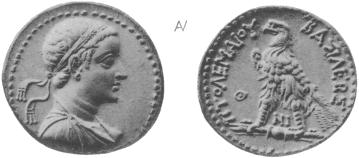
Ptolemy VI (Philometor), B.C. 181-146, was at first under the guardian- ship of his mother Cleopatra. To the period of her regency (B.C. 181- 174) Svoronos assigns, besides Cyprian AR (Nos. 1388-93), a group of Æ of the usual types (Nos. 1375-9), having Κ between the eagle’s legs (Hunter Cat., iii, Pl. LXXXIII. 15; B. M. C., Pl. XVI. 10, XVIII. 3, XXVI. 3), and also another (Nos. 1380- 2) with ΒΑΣΙΛΙΣΣΗΣ ΚΛΕΟΠΑΤΡΑΣ on obv. and ΒΑΣΙΛΕΩΣ ΠΤΟΛΕΜΑΙΟΥ on rev. (B. M. C., Pl. XXVI. 7, XXIII. 3, XVIII. 7). To the latter he attaches, in virtue of a monogram, yet a third group (Nos. 1383-7), on which the name of the queen does not occur (B. M. C., Pl. XXI. 3, XVI. 3). The foregoing were distributed by Poole over three different reigns, a proceeding for which strong stylistic arguments might be adduced.
On Cleopatra’s death the regency passed into the hands of Eulaeus, whose name (ΕΥΛ) is found on the rev. of five denominations of Æ (Svor., Nos. 1395-1402). He and his colleague Lenaeus conceived the ambitious design of recovering Phoenicia and Palestine for Egypt. The result was an invasion of the Nile delta by Antiochus IV, who assumed the ‘pro- tection’ of his young nephew, countermarking many of the ΕΥΛ coins with the Seleucid anchor (B. M. C., p. 81, Nos. 20 ff.), and even issuing an Egyptian currency (AR and Æ) in his own name (see supra, p. 763). The populace declined to submit to Syrian domination, and promptly trans- ferred the crown (B.C. 170) to the younger son of Epiphanes, afterwards Ptolemy VIII. A reconciliation between the brothers followed, and in the end Roman intervention compelled Antiochus to withdraw. For a few years the two Ptolemies reigned jointly, but in B.C. 164 the Cyrenaïca was definitely handed over to the younger as his special sphere. Svoronos may be right (Nos. 1423-8) in attributing to the joint-reign six denominations of Æ with rev. Two eagles (B. M. C., Pl. XXVI. 8 f., 12),
1 In his text (Νομ. Πτολ., i, p. τνθ, and iv, p. 274) Svoronos attributes to Cyprus a tetra- drachm with the head of Epiphanes, which in his Catalogue (No. 1291) he had given to Ptolemaïs or Joppa. Otherwise the head of Ptolemy I is universal on the AR tetradrachms of this series.
The Cyprian issues which commenced under Epiphanes were doubtless continued under Philometor. But it is impossible to be sure that the precise coins of this series ascribed to him by Svoronos (Nos. 1388-93, 1431-85)—whether AV octadrachms (Hunter Cat., iii, Pl. LXXXIII. 18) or AR tetradrachms (B. M. C., Pl. XIX. 1, 5-7)—are really his. The dates would also suit his brother, who was at once his contemporary and his successor. There are other pieces of even more doubtful attribution, such as the ‘χρυσα δεκαετηριδος‘ (Svor., No. 1498). Against these may be set a highly interesting AR tetradrachm (Svor., No. 1486), regarding which there is no possibility of question. It was struck at Ptolemaïs circ. B.C. 148, when Philometor intervened in the struggle between Alexander Bala and Demetrius II:—
| Head of Ptolemy VI, diademed. [B. M. C., Pl. XXXII. 8.] |
ΒΑΣΙΛΕΩΣ ΠΤΟΛΕΜΑΙΟΥ ΘΕΟΥ ΦΙΛΟΜΗΤΟΡΟΣ Eagle on fulmen; on wing, stalk of corn. |
Ptolemy VII (Eupator), B.C. 146, was murdered at his uncle’s instiga- tion almost immediately upon his accession. Although he seems to have left no coins of his own, an AR Cyprian tetradrachm dated LΑϚ ΚΑΙ Α (B. M. C., Pl. XXXII. 9) is perhaps a relic of the brief period during which he was associated with his father in the kingdom, the thirty-sixth year of Philometor being the first of Eupator. [1]
Ptolemy VIII (Euergetes II), B.C. 170-116, surnamed Physcon, did not really become monarch until B.C. 146, when he returned from Cyrene and succeeded his murdered nephew. But he always reckoned his regnal years from his first proclamation by the Egyptians. Among the coins of the ordinary Cyprian series which are given to him by Svoronos (Nos. 1501-1620), those with dates between 37 (LΛΖ) and 54 (LΝΔ) must certainly be his (B. M. C., Pl. XXI. 10 f., XXII. 4, XXIII. 1 f., 4-7), for no other among the later kings reigned for more than thirty- six years. As regards the rest, it is not possible to discriminate accurately between his issues and those of his brother, except in the case of Very scarce didrachms of the year 33 (Svor., No. 1507). These bear a radiate head which is clearly not that of Philometor, and therefore presumably represents Physcon. Another attribution that is scarcely doubtful is the dated Æ (Nos. 1621-32) with a lotus-flower in the field of the rev. (B. M. C., Pl. XX. 4 f.). Similar Æ undated (Svor., Nos. 1636-9) may well be his also (B. M. C., Pl. XIX. 3). Both the last-mentioned seem to have been minted in Cyprus, and it is possibly from the same island that there come several denominations of Æ (Svor., Nos. 1640-56) with rev. ΒΑΣΙΛΕΩΣ ΠΤΟΛΕΜΑΙΟΥ ΕΥΕΡΓΕΤΟΥ Double cornucopiae (B. M. C., Pl. XXIV. 1) or Eagle (B. M. C., Pl. XXII. 7-9). Svoronos's attribution (Nos. 1499 f.) of ‘χρυσα δεκαετηριδος‘ to B.C. 134 (B. M. C., Pl. VIII. 10) is only a surmise. On the other hand, two denominations of Æ (Svor., Nos. 1657 f) with rev. Head of Libya must belong to
1 This view is, however, rejected by Svoronos (No. 1509) who explains the legend differently (Νομ. Πτολ., i. p. τ-β, and iv, pp. 305 f.).
Ptolemy IX (Neos Philopator), B.C. 121-117, has left no coins. He predeceased his father, after having been co-regent for a year or two.
Ptolemy X (Soter II, Lathyrus), Cleopatra III, and Ptolemy XI (Alexander I), B.C. 116-80, fill a very confused page of Egyptian history (Νομ. Πτολ., i. pp. υζ ff., and iv, pp. 320 ff.; Z. f. N., xxv, pp. 385 ff.). Ptolemy VIII left the regency to his widow Cleopatra III. She would have preferred to have the younger of the princes as a colleague, but was only able to secure for him the governorship of Cyprus, his appointment to which, however, in B.C. 114 he always regarded as the beginning of his reign as Ptolemy XI. His elder brother reckons his regnal years, like Cleopatra, from the death of Physcon. In B.C. 107 Alexander returned to Egypt, forced his brother to withdraw, and established himself in his stead. In B.C. 101 he murdered Cleopatra, with whom he had up till now reigned jointly, and in the same year he acknowledged his brother as king of Cyprus. Lathyrus ruled Cyprus till B.C. 88, when Alexander died. He then came back to Alexandreia, and reigned undisturbed till his death in B.C. 80. The only AR coins of this period that can be attributed with perfect certainty are tetra- drachms of the Cyprian class with ΠΑ (Svor., Nos. 1727-31), struck between B.C. 106 and 101. They bear double dates that can only represent the regnal years of Cleopatra and of Alexander (B. M. C., Pl. XXVIII. 1 f.). The remainder of the dated AR falls into three groups: (a) Svor., Nos. 1659-88: tetradrs., and very rare didrs., drs. and ½ drs., with ΠΑ and dates from LΑ to LΛC (B. M. C., Pl. XXVI. 4-6, XXVII. I f., &c.); (β) Svor., Nos. 1689-93: tetradrs., with ΠΑ or ΣΑ and dates from LΙΗ to LΚΖ (B. M. C., Pl. XXVII. 3, XXXII. 10); (γ) Svor., Nos. 1734- 84: tetradrs., with ΠΑ, ΣΑ, or ΚΙ and dates from LΑ to LΙ (B. M. C., Pl. XXVI. 2, XXVII. 5-8). On the difficulty of distributing these among the different claimants see Z. f. N., xxv, pp. 386 ff. The task would be simpler if it were certain when ΠΑ ceased to have a purely local significance and came to be placed on coins minted at Alexandreia, as it undoubtedly was later. There are Æ pieces (Svor., Nos. 1717- 22) with rev. ΒΑΣΙΛΕΩΣ ΠΤΟΛΕΜΑΙΟΥ ΣΩΤΗΡΟΣ (ΣΩ, ΣΩ ΘΕ) Eagle, Double cornucopiae, or Head-dress of Isis (B. M. C., XXVI. 10 f.), which must have been struck by Ptolemy X. Other Æ (Svor., Nos. 1694-1716, and 1724 f.) are more uncertain, as are the ‘χρυσα δεκαετηριδος‘ which Svoronos (No. 1726) believes to have been issued in B.C. 107 on the twentieth anniversary of Cleopatra’s marriage. Ptolemy Apion, a natural son of Physcon, was regent in Cyrene for some part of the period under discussion, but his coins cannot now be identified.
Ptolemy XII (Alexander II), B.C. 80, son of Ptolemy XI, reigned only nineteen days. Svoronos (Nos. 1732 f.) assigns to Alexander I and Cleopatra III the Æ that used to be attributed to Alexander II and Cleopatra Berenice III, or to Ptolemy Apion (B. M. C., Pl. XXVIII. 9).
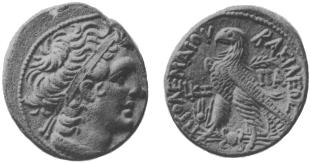
Cleopatra VII, B.C. 51-30, daughter of Auletes, was the dominating personality throughout the closing years of the dynasty. Her brothers, Ptolemy XIV and XV, and her son, Ptolemy XVI (Caesarion), were no more than puppets. Svoronos (Nos. 1847-52, 1854-70) ascribes to her a series of AR of the usual types, with dates from LΑ to LΚΓ (B. M. C., Pl. XXIX. 4-8), which Feuardent and Poole had given to a younger brother of Auletes, who was at one time king in Cyprus. Regling prefers to assign these to Auletes himself (Z. f. N., xxv, p. 393 f.), substituting them for series (α) described above, which he attributes to Cleopatra, thus making the tetradrachms with the head-dress of Isis a continuous series, divided between two monarchs. A strong argument in favour of this arrangement is the occurrence of the same symbol, also with ΠΑ, on a remarkable drachm (Svor., No. 1853), struck in the year B.C. 46, and bearing a portrait of Cleopatra (B. M. C., Pl. XXX. 5). Very special interest centres round a group of Æ with obv. Head of Cleopatra, rev. ΒΑΣΙΛΙΣΣΗΣ ΚΛΕΟΠΑΤΡΑΣ, Eagle on fulmen (Svor., Nos. 1871 f.). There are two denominations marked Π and Μ respectively (B. M. C., Pl. XXX. 7 f.). Regling (Z. f. N., xxiii, pp. 115 f.) has proved conclusively that these letters are numerals (= 80 and 40), denoting the number of copper drachmae that each denomination contained (see supra, p. 846). Apparently at this time the copper drachma weighed only 4 or 5 grains. On Æ struck probably in Cyprus (Svor., No. 1874) the queen appears as Aphrodite with the infant Caesarion as Eros in her arms (B. M. C., Pl. XXX. 6). Her union with M. Antonius meant the recovery by Egypt of its lost dominion over Phoenicia and Palestine. Hence the issue at Ascalon (see supra, p. 804) of AR tetradrachms with Cleopatra’s portrait. These represent a revival of the old Phoenician coinage of the Seleucid kings (see supra, p. 765), just as the Æ pieces of Berytus, Tripolis, and
[R. S. Poole, Brit. Mus. Cat., Alexandria, &c., 1892;
G. Dattari, Numi Augg. Alexandrini, Cairo, 1901,
and also various articles in Riv. Ital. di Num., 1900, and following years;
G. Macdonald, Hunter Cat., vol. iii, 1905, pp. 402-566.]
‘Augustus inter alia dominationis arcana ... seposuit Aegyptum,'
says Tacitus (Annal. ii. 59). And down to the days of Diocletian the status
of the province remained exceptional. It was in a peculiar sense the property
of the emperor, and was controlled by a praefectus responsible to him alone.
Its unique position is reflected in the fact that it had a special currency of
its own. Roman gold is found in Egypt; but prior to circa A.D. 260 neither Roman
denarii nor Roman bronze coins appear to have been imported (N. C., 1908, p. 300).
The long series of Egyptian imperial money extends down to the brief reign of
the pretender Domitius Domitianus, A.D. 296-7, and includes coins struck in the
name of the Palmyrene Queen Zenobia and of Vaballathus. It begins with Augustus,
whose earliest pieces betray a desire to be regarded, not as a foreign ruler,
but as the direct heir of the Ptolemies. Except for the name and portrait, they
exactly resemble the Æ with Π and Μ described above as having been
minted by Cleopatra VII. The use of value-marks was soon abandoned. Simultaneously
novel types were introduced. It is, however, extremely improbable that any great
significance attaches to these changes. It was left to Tiberius to carry through
a radical reform.
In A.D. 19 the last-named emperor revived the Ptolemaic tetradrachm, the issue of which had been in abeyance since Cleopatra’s death. It was now struck not in debased AR, but in the mixture of AR and Æ known as billon. Regimental pay-sheets of the first century A.D. show that it was tariffed as roughly equivalent to the Roman denarius, but that for purposes of exchange a distinct advantage rested with the denarius, which was held to be worth 28 or 29 obols as against the normal 24 (Mommsen, Archiv für Papyrusforschung, i, pp. 273 ff., and A. von Prernerstein, Beiträge zür alten Geschichte (Klio), iii, pp. 8 ff.). The general effect of the reform was to facilitate commercial intercourse between Egypt and the rest of the Empire. At first the billon tetradrachm weighed over 200 grains and contained a fair proportion of AR. Deterioration rapidly set in. One of the most notable debasements took place in the reign of Commodus, when the percentage of AR was reduced to 10. The next great shrinkage began under Trebonianus Gallus, and continued till the time of Diocletian under whom the tetradrachm weighed little more than one-half of what it had originally done, while the proportion of AR sank as low as 2 per cent. An indirect effect of this process should be noted. The earlier emperors had all struck coins in Æ, pieces of very large module being introduced by Nero and minted in enormous quantities by Trajan, Hadrian, and Pius. Under Commodus the flow was suddenly checked, while under the later emperors Æ is hardly known at all. There was no longer any room for it even as a token-coinage. On the other hand, it is almost certainly to this period
The tetradrachms and the imperial Æ always have the imperial portrait on
the obv. They were doubtless minted at Alexandreia, which was at once the seat
of the government and the busiest commercial centre in the whole of the Roman
world. But the name of the city never appears except on certain alliance-coins
struck at Ephesus under Gordian III. Like the Æ of Cleopatra on which it
was modelled, the earliest Æ of Augustus was undated. Some time before the
close of his reign there was a resumption of the Ptolemaic fashion of placing
upon the coins the regnal year of the monarch in whose name they were issued.
This practice continued to be observed till the very close of the series, and,
since the Alexandrian year commenced on August 29, the dates and corresponding
inscriptions are often useful in elucidating obscure points of Roman imperial
chronology. As a rule, the year is indicated by a numeral letter or letters preceded
by the symbol L (see supra, p. 847). Occasionally, however, the symbol L is replaced
by ΕΤΟVΣ (Hunter Cat., iii, pp. 424 ff., 459, 474, 543
ff., 547 ff., and 551). Sometimes, too, the actual numeral is written as a word.
This happens much more frequently in the case of ΕΝΑΤΟV
and ΕΝΝΕΑΚΑΙΔ(εκατου)
than in the case of any other numbers. There appears to have been a superstitious
reluctance to employ the letter Θ in such a connexion (Riv. Ital., 1901, p.
380). At the same time it is noteworthy that under Hadrian and Pius L ΕΝΑΤΟV
ushers in a series that runs as far as L ΤΡΙΣΚ(αιδεκατου).
Very rarely we find, instead of LΙ, the words ΠΕΡΙΟΔ
· ΔΕΚΑΕΤ (Commodus), ΠΕΡΙΟΔΟC
ΔΕΚΑΤΗ (Severus Alexander), or ΔΕΚΑΕΤΗΡΙC
ΚVΡΙΟV (Gallienus)—obvious allusions to the
vota decenalia, a festival which was also commemorated by the placing of a palm
in the field of the rev. in the years that followed its celebration (Hunter
Cat., iii, p. 499 and p. 531).
Besides these variations, more or less marked modifications in the form of the obv. inscr. or in the treatment of the imperial head, as well as changes in the general character of the types of the rev., often occur at irregular intervals in the course of a single reign; for details see Hunter Cat. iii, where they are made the basis of classification. A good example is furnished by the billon coinage of Nero. It falls into three quite distinct groups, corresponding to three successive periods of time, and differentiated partly by the characteristics of the obv. and partly by the use of three well-marked varieties of rev. type, to each of which a special set of family portraits is attached. The first group is distinguished by the frequent choice of personified qualities such as are common on Roman coins. The second exhibits a preference for subjects drawn from Egyptian mythology and religion. The chief feature of the third is the number of heads of Greek gods and goddesses. Modifications of the nature described usually take place in the middle of a year. As the year used for dating is the
The more important of the types are discussed in detail by Poole in his Introduction
to B. M. Cat., Alexandria, &c. (q. v.). Here space forbids
anything beyond a simple enumeration:—
(α) Greek Types. Bust or fulll length figure of Kronos holding sickle. Bust of Zeus (ΔΙΟΣ ΟΛΥΜΠΙΟΥ, ΖΕΥΣ ΝΕΜΕΙΟΣ) or full-length figure enthroned (ΖΕΥΣ ΚΑΠΙΤΩΛΙΟΣ), or recumbent on eagle. Bust of ZeusAmmon, or full-length figure in biga drawn by rams. Bust of Hera (ΗΡΑ ΑΡΓΕΙΑ), or standing figure. Bust of Poseidon (ΠΟΣΕΙΔΩΝ ΙΣΘΜΙΟΣ), or figure in biga of hippocamps or standing holding dolphin. Bust of Apollo (ΑΚΤΙΟΣ or ΠΥΘΙΟΣ ΑΠΟΛΛΩΝ), or figure standing or seated; Apollo Didymeus, with stag and bow, sometimes between Nemeses; Apollo and Artemis; &c. Artemis Huntress. Bust of Athena, or figure enthroned, or standing (ΑΘΗΝΑ ΣΕΒΑΣΤ), holding Nike, owl or ears of corn, sometimes before altar; Athena Stathmia; Athena Archegetis of Sais; Athena and Demeter; Athena and Ares. Bust of Ares, or figure standing. Bust of Demeter, or figure standing alone (ΔΕΜΗΤΗΡ), or between the Dioskuri, or with Euthenia or Harpocrates. Persephone carried off by Hades. Bust of Helios, alone or with Selene, or figure standing or on horseback; see also Sarapis infra. Bust of Selene, alone or with Helios, or figure in biga. Kybele enthroned. Bust of Dionysos, or figure in panther-car. Triptolemos in serpent-car. Bust of Asklepios, or figure standing alone or with Hygieia. Bust of Hygieia, or figure standing alone or with Asklepios. Bust of Hermes, or figure seated or standing. Pan. Busts of the Dioskuri, or figures on horseback or standing. ΗΩΣ holding prancing horse. Nike, frequently and variously represented; rarely with inscr., ΝΕΙΚΗ CΕΒΑCΤ, ΝΙΚΗ ΚΑΤΑ ΓΕΡΜΑΝΩΝ (Domitian), ΚΑΙΣΑΡΙ ΝΙΚΗ (Trajan), ΝΕΙΚΗ ΚΑΤΑ ΒΡΕΤΑΝ (Severus and family). Tyche standing (ΤVΧΗ CΕΒΑCΤ), or seated, or recumbent on couch. Exploits of Herakles (Æ of Pius)—Nemean lion; Hydra; Keryneian stag; Erymanthian boar; Augean stables; Stymphalian birds; Cretan bull; Mares of Diomedes; Oxen of Geryon; Gardens of the Hesperides; Kerberos; Antaeos; Herakles entertained by the Centaur Pholos; Destroying vines of Syleus; Slaying the Amazon Hippolyte, the monster Echidna, &c. Perseus and Andromeda. Orpheus charming the wild beasts. Judgment of Paris. ΟΚΕΑΝΟΣ as river-god.
(β) Egyptian and Graeco-Egyptian Types. Bust of ΖΕΥΣ ΣΑΡΑΠΙΣ wearing modius. ΖΕΥΣ ΣΑΡΑΠΙΣ or ΗΛΙΟΣ ΣΑΡΑΠΙΣ standing or enthroned. Pantheistic bust of Sarapis, Zeus Ammon, Poseidon, &c. Sarapis standing or seated, alone or with Demeter, Agathodaemon, Homonoia, &c., or between the Dioskuri. Bust of Isis, alone or with Sarapis, or figure standing or seated, sometimes in temple or suckling infant Horus; Isis Pharia holding inflated sail before Pharos lighthouse; Isis Sothis on dog. Hathor-Isis (?) (Hunter Cat., iii, Pl. LXXXVI. 15). Bust of Harpokrates, or figure as infant or youth, standing or seated on flower, finger at mouth. Bust of Hermanubis with palm-branch and caduceus, or figure standing with jackal at feet. Bull Apis. Bust of ΝΙΛΟΣ, or figure with cornucopiae and reed, recumbent or seated, accompanied by crocodile
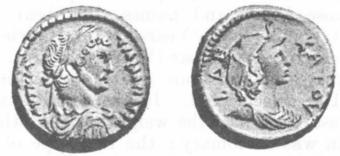
(γamma) Astronomical Types. Summer (Dattari, Nos. 2986-9). Autumn (Dattari, No. 2985). Phoenix, inscr. ΑΙWΝ, referring to commencement of Sothic cycle (Year 2 of Pius = A.D. 139). Zodiac in circle round busts of Helios and Selene. Two zodiacs in double circle round busts of Sarapis and Isis. Zodiac in circle, with inner ring containing Sun, Moon, and major planets, round bust of Sarapis. Head of Helios over lion, indicating the Sun in Leo; and similar representations of the Moon in Cancer, Mercury in Gemini and in Virgo, Venus in Taurus and in Libra, Mars in Aries and in Scorpio Jupiter in Aries in Sagittarius and in Pisces, Saturn in Capricorn and in Aquarius. The zodiacal types all belong to the year 8 of Pius (cf. Riv. Ital., 1901, pp. 157 ff.).
(δ) Graeco-Roman Types. Bust of Roma, or ΡΩΜΑ seated or standing. ΔΗΜΟΣ ΡΩΜΑΙΩΝ standing. Trophy between captives, sometimes with ΑΡΜΕΝΙΑ (Verus). Wolf and twins. Right hands clasped, sometimes with ΟΜΟΝΟΙΑ (Verus). ΤΙΒΕΡΙΣ (see supra under ΝΙΛΟΣ).
(ε) Personifications of abstract conceptions. These are mostly copies of familiar Roman types—ΑΦΙΕΡCΙC (Consecratio), ΔΙΚΑΟΣΥΝΗ, ΔΥΝΑΜΙΣ (Venus Victrix), ΕΙΡΗΝΗ, ΕΙΡΗΝΗ ΚΑΙ ЄVΘΗΝΑ, ЄΙΡΗΝΗ ΚΑΙ ΟΜΟΝΟΙΑ, ΕΛΕΥΘΕΡΙΑ, ΕΛΠΙC, ЄΥΘΗΝΙΑ (Abundantia), usually associated with Nilus, Eutycheia (Felicitas), ΚΡΑΤΗΣΙΣ (Virtus), ΜΟΝΕΤΑ, ΟΜΑΝΟΙΑ, Eusebeia (Pietas), ΠΡΟΝΟΙΑ, ΣΗΜΑΣΙΑ (Female figure on galloping horse, brandishing sword), &c.
(ζ) Personal Types. Emperor seated, standing, on horseback; in biga of centaurs, of elephants, of Tritons; in quadriga of horses, of elephants; beside prisoners, once with ΒΡΕΤΑΝΝΙ (Commodus of A.D. 185-6); with Alexandreia, Ares, Demeter, Nike, Pronoia, Roma, Sarapis, &c. Hadrian welcomed by Alexandreia. Bust of Antinous (ΑΝΤΙΝΟΟΥ ΗΡΩΣ) or Antinous on horseback as Hermes. Commodus as ΡWΜΑΙWΝ ΗΡΑΚΛΕΑ. And many others.
There still remain to be mentioned the curious series of Æ pieces which bear on the rev. the names of the various νομοι or administrative districts into which ancient Egypt was divided. These Coins of the Nomes were not issued locally. They were struck at Alexandreia, a circumstance which robs them of the interest they would otherwise have
ΑΘΡΙΒΙΤΗC, ΑΛΕΞανδρεων Χωρα, ΑΜΜΟΝΙΑΚΗΤΗC (?), ΑΝΤΑΙΟΠΟΛΙΤΗC, ΑΠΟΛΛWΝΟΠΟΛΙΤΗC, ΑΡΑΒΙΑ, ΑΡCΙΝΟЄΙΤΗC, ΑΦΡΟΔЄΙΤΟΠΟΛΙΤΗC, ΒΟVΒΑCτιτης, ΒΟVCΙΡΙΤης, ΓVΝΑΙΚοπολιτης, ΔΙΟΠΟΛΙτης ΜЄγας, ΔΙΟΠολιτης Κατω τοπον, ЄΡΜΟΠΟΛΙΤΗC, ΕΡΜWΝΘιτης, ΗΛΙΟΠΟΛЄΙΤης, ΗΡΑΚΛЄWΠΟΛΙΤΗC ΝΟΜΟC, ΘΙΝΙτης, ΚΑΒΑCΙτης, ΛΑΤΟΠΟΛιτης, ΛЄΟΝΤΟΠΟΛΙΤΗC, ΛΗΤΟΠολιτης, ΛΙΒVΗ, ΛVΚΟπολιτης, ΜΑΡΕWΤΗC, ΝΟΜΟC ΜΕΜΦЄΙΤΗC, ΜЄΝΔΗCΙΟC ΝΟΜΟC, ΜЄΝЄΛΑЄΙΤΗC, ΜЄΤΗΛΙτης, ΝΑVΚΡΑΤΙC, ΝЄCVΤης, ΝΟΜΟC ΞΟΙΤΗC, ΟΑCЄΙτης, ΟΜΒΙΤΗC, ΟΝΟVΦιτης, ΝΟΜΟC ΟΞVΡVΝΧΙΤΗC, ΠΑΝΟΠολιτης, ΠΛΟVCΙΟV (?), ΠΡΟCWΠΙΤΗC, CΑЄΙΤΗC ΝΟΜΟC, ΝΟΜΟC CЄΒЄΝΝΥΤΗC, CЄΒЄννυτης Κατο τοπον, CΕΘΡWΕΙΤΗC ΝΟΜΟC, ΤΑΝΙΤΗC, ΤЄΝΤVΡιτης, VΨΗΛΙτης, ΦΑΡΒΑΙτιτης, ΦΘΕΜΘονθις (?), ΦΘΕΝΕΟVτης.